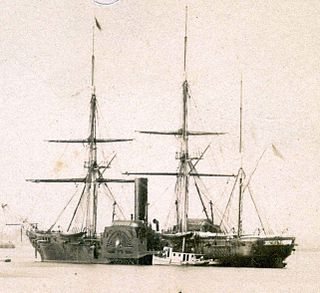
USS Susquehanna, a sidewheel steam frigate, was the first ship of the United States Navy to be named for the Susquehanna River, which rises in Lake Otsego in central New York and flows across Pennsylvania and the northeast corner of Maryland emptying into the Chesapeake Bay.
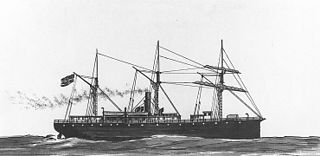
The third USS Montgomery was a wooden screw steamer in the Union Navy during the American Civil War.

The first USS Seminole was a steam sloop-of-war in the United States Navy during the American Civil War.

The first USS Pocahontas, a screw steamer built at Medford, Massachusetts in 1852 as City of Boston, and purchased by the Navy at Boston, Massachusetts on 20 March 1855, was the first United States Navy ship to be named for Pocahontas, the Algonquian wife of Virginia colonist John Rolfe. She was originally commissioned as USS Despatch – the second U.S. Navy ship of that name – on 17 January 1856, with Lieutenant T. M. Crossan in command, and was recommissioned and renamed in 1860, seeing action in the American Civil War. As Pocahontas, one of her junior officers was Alfred Thayer Mahan, who would later achieve international fame as a military writer and theorist of naval power.

USS Albatross was a screw steamer rigged as a three-masted schooner acquired by the Union Navy during the beginning of the American Civil War. She was outfitted as a gunboat with heavy guns and used in the Union blockade of the waterways of the Confederate States of America.

USS Kennebec was a Unadilla-class gunboat built for the U.S. Navy following the outbreak of the American Civil War. She was named for the Kennebec River.

USS Sagamore was a Unadilla-class gunboat built on behalf of the United States Navy for service during the American Civil War. She was outfitted as a gunboat and assigned to the Union blockade of the Confederate States of America. Sagamore was very active during the war, and served the Union both as a patrol ship and a bombardment vessel.
USS Itasca was a Unadilla-class gunboat built for the U.S. Navy during the American Civil War. She was used by the Navy to patrol navigable waterways of the Confederacy to prevent the South from trading with other countries.

USS Unadilla was a Unadilla-class gunboat built for service with the United States Navy during the American Civil War. She was the lead ship in her class.

USS Huron was a Unadilla-class gunboat built for the United States Navy during the American Civil War for blockage duty against the ports and rivers of the Confederate States of America.

USS Quaker City was a heavy, 1,428 long tons (1,451 t) sidewheel steamship leased by the Union Navy at the start of the American Civil War. She was subsequently purchased by the navy, outfitted with a powerful 20-pounder long rifle, and assigned to help enforce the Union blockade of the ports of the Confederate States of America.
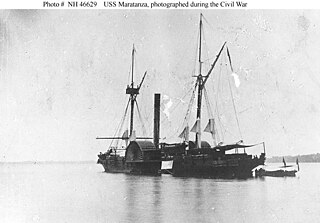
USS Maratanza was a steamer acquired by the Union Navy during the American Civil War. She was used by the Union Navy as a gunboat to patrol navigable waterways of the Confederacy to prevent the South from trading with other countries.
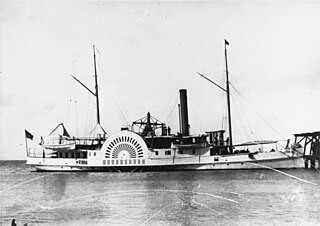
USS Delaware was a steamer acquired by the Union Navy for use during the American Civil War. She had a very active naval career as a gunboat for over three years, and after the war served as a revenue cutter for over 37 years. The steamer was sold to the private sector in 1903, and disappeared from shipping registers in 1919.
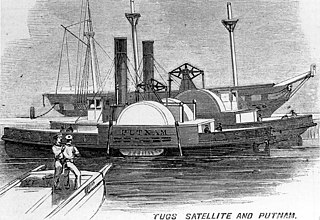
USS General Putnam – also known as the USS William G. Putnam – was acquired by the Union Navy during the first year of the American Civil War and outfitted as a gunboat and assigned to the Union blockade of the Confederate States of America. She also served as a tugboat and as a ship's tender when so required.
USS Western World was a ship acquired by the Union Navy during the American Civil War. She was used by the Navy to patrol navigable waterways of the Confederacy to prevent the South from trading with other countries.
USS Dan Smith was a schooner used by the Union Navy during the American Civil War. She was used by the Navy to patrol navigable waterways of the Confederacy to prevent the South from trading with other countries.

USS Thomas Freeborn was a steam tug acquired by the Union Navy during the American Civil War. She was used by the Navy as a gunboat to patrol navigable waterways of the Confederacy to prevent the South from trading with other countries.

USS Lodona was a British steamship of the same name captured by the Union Navy during the American Civil War. She had been built in England for shipowner Zachariah Pearson and attempted to break the United States' blockade of Confederate ports. USS Lodona was used by the Navy to patrol waters off those ports. After the war she returned to commercial ownership.
USS Wamsutta was a steamer constructed for service with the Union Navy during the American Civil War. She was used by the Union Navy as a gunboat in support of the Union Navy blockade of Confederate waterways.

John Cummings Howell was an officer in the United States Navy during the American Civil War. He rose to the rank of rear admiral and late in his career was commander-in-chief of the North Atlantic Squadron and then of the European Squadron.
















